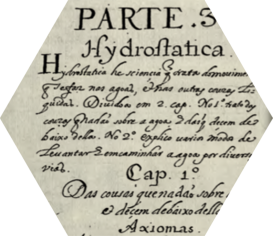Hendrick Uwens (1618–1667) was a Flemish-educated Jesuit who became a missionary to the Mughal Empire. Prior to embarking on his missionary work, he taught mixed mathematics in Lisbon, Portugal, in the early 1640s. As part of his teaching, he wrote a 400-page manuscript textbook in Portuguese on statics. Before addressing the motion of water, Uwens explains the nature of water. He argues that water has no viscosity, following the teachings of Galileo. Uwens presents three experiments to support his point, which are the experiments in this source. These experiments are the same as the ones used by Galileo in last book, Two New Sciences (Leiden, 1638), published only seven years earlier. Thus, these sources show how rapidly Galileo’s experiments spread through their teaching in Lisbon and in the vernacular. Uwens knew of philosophical problems arising from these experiments. But rather than criticizing the work of natural philosophers, as Galileo did, Uwens only stated that the mixed mathematics followed a different method than natural philosophy. By repurposing Galileo’s experiments in a classroom setting, Uwens helped to transform and disseminate key ideas of the new sciences through early modern Europe.

Hendrick Uwens
